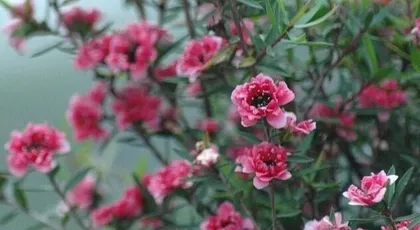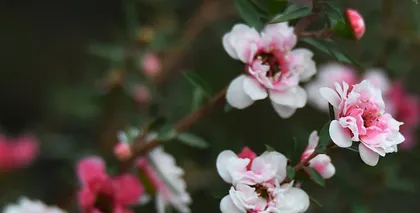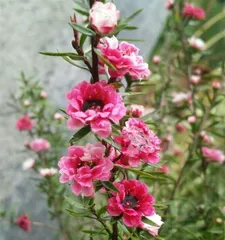Leptospermum scoparium is a beautiful plant, deeply loved by people. Planting Leptospermum scoparium in the garden can not only decorate the environment but also effectively improve air quality and increase natural oxygen. However, due to some special requirements in its growth process, many people are not familiar with the cultivation methods and precautions for Leptospermum scoparium. This article will provide you with a comprehensive guide to growing Leptospermum scoparium, helping you create a beautiful Leptospermum scoparium garden.

Understanding the Ecological Habits of Leptospermum Scoparium
Leptospermum scoparium is an evergreen shrub native to China, South Korea, and Japan. It prefers to grow in a warm and humid environment, is relatively cold and drought tolerant, and enjoys a full sun or partial sun environment.
Choosing Suitable Soil and Environment
Leptospermum scoparium requires fertile, well-draining soil to grow, and it has a certain tolerance for acidic soil. To achieve the best growth results, you can choose sandy loam or limestone soil, while ensuring they have good drainage.

Choosing a Suitable Location
When planting Leptospermum scoparium, it is important to choose a suitable location. If Leptospermum scoparium receives too much sun exposure during the growing season, its leaves will turn yellow, wilt, and even fall off. Therefore, it is advisable to choose a semi-shaded or well-ventilated environment to reduce direct sunlight.
Mastering the Appropriate Planting Time
The best time to plant is usually in spring or autumn. During these two seasons, the temperature is relatively mild, which is suitable for the growth of Leptospermum scoparium. However, it should be noted that during hot or cold seasons, Leptospermum scoparium does not easily germinate and grow.
Steps for Planting Leptospermum Scoparium
First, you need to soak the Leptospermum scoparium in advance to allow them to absorb sufficient water. Then, transplant it into the prepared soil, making sure the depth is the same as the original planting depth. Finally, gently press the soil and water thoroughly.

Watering Appropriately
Leptospermum scoparium likes a moist environment, but overwatering can lead to waterlogged soil. This can damage the roots, causing the plant to grow slowly or even die. Therefore, when watering, control the amount appropriately and just keep the soil slightly moist.
Fertilization Techniques
Leptospermum scoparium needs proper nutrition during its growth process, so it requires regular fertilization. Fertilization should be done before the growing season and the flowering period. You can use fertilizers containing nitrogen, phosphorus, and potassium to meet the nutritional needs of Leptospermum scoparium.
Pruning Leptospermum Scoparium
Pruning is an important step in maintaining the healthy growth of Leptospermum scoparium. Before spring arrives, it is necessary to prune off old, dead, and diseased branches. Then, during the growing period, it is necessary to regularly remove excess leaves and buds, and control the number of flower buds.
Pay Attention to Pest and Disease Control
Leptospermum scoparium may be susceptible to pests and diseases during its growth. Some common pests and diseases include aphids, red spiders, and black spot disease. To prevent and control these pests and diseases, appropriate insecticides and fungicides can be used.
Reasonable Harvesting and Storage
When the flowering period of Leptospermum scoparium arrives, it is necessary to harvest the flowers in a timely manner. To ensure the flowers remain fresh, they should be stored in a cool, ventilated place, and the stems should be kept moist. It is important not to expose the harvested flowers to direct sunlight.
Enhancing Light Exposure
Leptospermum scoparium requires relatively sufficient sunlight, which helps its growth and flowering. In a relatively dark environment, you can promote the growth of Leptospermum scoparium by increasing light exposure.
Maintaining Stable Temperature
Leptospermum scoparium has relatively stable temperature requirements during its growth process. Temperatures that are too low or too high can cause damage to it. When planting Leptospermum scoparium, it is important to maintain a stable temperature.
Avoid Frequent Transplanting
Transplanting is one of the factors that affects the healthy growth of Leptospermum scoparium. Frequent transplanting can cause it to be damaged and affect its growth. When planting Leptospermum scoparium, choose the most suitable location and try to minimize the number of transplants.
Timely Thinning of Branches
During the growth process, Leptospermum scoparium will grow some excess branches and leaves, which can affect its normal growth and flowering. It is necessary to thin out the branches in a timely manner to maintain the stability and beauty of the plant's shape.
This article introduces the cultivation methods and precautions for Leptospermum scoparium. Only by mastering this knowledge can you make Leptospermum scoparium healthier and more beautiful during its growth, enriching your life. Through proper planting and care, I believe you can create a charming Leptospermum scoparium garden in your own garden!